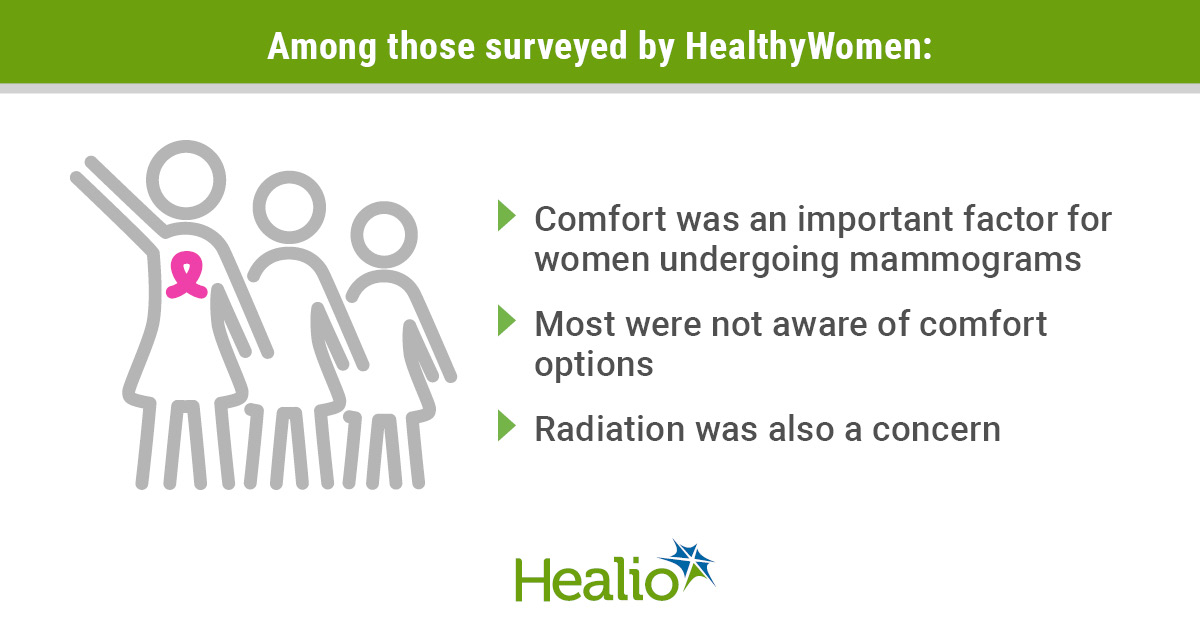‘Empowerment is key’ to improving women’s comfort level with mammograms

In a recent survey, nearly one in six women aged older than 40 years said the discomfort they felt about mammograms made them delay or completely avoid having one.
“These concerns are real and deserve our focus, as screening mammograms play a critical role in early breast cancer detection,” Pam Cumming, director of women’s health at Siemens Healthineers North America, the company that commissioned the survey, told Healio Primary Care.
“The physician who refers a patient [for a mammogram] is often her OB/GYN or general practitioner and is often viewed as the gatekeeper for her health and the first line of communication for women,” Cumming continued. This creates the ideal environment to discuss why breast cancer screening is critical to early cancer detection. Information is key. Empowerment is key.”
Brandy Griffith, DO, radiologist at The Ohio State University Comprehensive Cancer Center, agreed that a frank discussion about the mammogram process helps ease the patient’s discomfort.

“Explain the exam so that women understand what is going to happen,” she said in an interview. “Some women may find it uncomfortable but the exam is quick — the total exam takes 10-15 minutes to complete and each compression lasts less than a minute.”
Griffith added that the timing of the mammogram and some over-the-counter pain medications can alleviate discomfort.
“Schedule the test for a time when your breasts are least likely to be tender. That is usually the week after your period.” she said. “They may also consider taking acetaminophen or ibuprofen about an hour before the mammogram to ease the discomfort.”
The personal touch that a clinic’s employees provide their patients also plays a role in a woman’s comfort level, according to the survey.
The poll indicated that 54% of women said they would be highly motivated to undergo regular mammograms if they knew that a medical practice provided a more comfortable and tailored mammogram experience. Approximately half (49%) said they would be very likely to seek out practices that offered these types of experiences.
Practices can personalize the mammogram by adjusting the X-ray machine to the patient’s height and weight.
In addition, Cumming explained that many patients may not realize that “mammography technology and treatments have come a long way” since the technology was first introduced in the late 1960s. Sophisticated image acquisition and advanced image processing algorithms provide radiologists with highly detailed image quality, she added.
“For example, today the resolution of a 3-D tomosythesis mammogram can help the radiologist see through dense breast tissue where cancers can hide,” Cumming said. Finding cancer in a dense breast can feel like looking for snowflake in a blizzard,” Cumming said.
Fears about radiation may also be an issue. In the survey, nearly 16% of respondents who had not had a mammogram expressed concern about it.
Cumming told Healio Primary Care that telling patients who are concerned about radiation that the Mammography Quality Standards Act “regulates mammography closely to ensure that patients are receiving the lowest possible dose without sacrificing the image quality” often reassures them and eliminates their concern.

Griffith added that putting the radiation dose into context of everyday life also helps ease patient fears.
“The radiation from a screening mammogram is less than the radiation we all receive from 2 months of exposure to natural sources of radiation. The benefit of detecting a cancer early outweighs the potential small risk from the additional radiation of a screening mammogram,” she said.
Griffith and Cumming both emphasized the importance of reminding women of the annual mammogram’s purpose.
“The point is to detect breast cancer before it can be felt, when it is at a smaller size, earlier stage, and more likely to be curable.” Griffith said.
Griffith and Cumming both emphasized the importance of reminding women of the annual mammogram’s purpose.
“The point is to detect breast cancer when it is so small that you can’t feel it, but we have better treatment options,” Griffith said.
Cumming added that patients need to be reminded that mammograms are not a one-off exam.
“You’ll often hear patients say how they are not going to be the one in eight women that will get breast cancer,” she said. “You’ll often hear them say how they made it through one mammogram and they don’t need another. You need to push back with the reminder that this risk is over a lifetime, not a moment in time.” – by Janel Miller
Reference: American Cancer Society. History of cancer screening and early detection. https://www.cancer.org/cancer/cancer-basics/history-of-cancer/cancer-causes-theories-throughout-history11.html. Accessed Oct. 17, 2019.
Disclosures: Cumming works for Siemens Healthineers North America. Griffith reports no relevant financial disclosures.
